Genetic technology is expanding at a pace that few can keep up with, with huge amounts of data being generated every week. But is this explosion of information delivering meaningful advances for patients? Plus, how one scientist tracked down the gene fault behind his own disease, what sequencing the HeLa genome means for genetic privacy, and a Pythonesque gene of the month.
In this episode

01:05 - Dr Matt Hurles - Spring Meeting
Dr Matt Hurles - Spring Meeting
with Dr Matt Hurles, Wellcoime Trust Sanger Institute
Kat - Last month I was at the Royal Society in London for the Genetics Society Spring meeting, Genomics for Health and Society. It was a fascinating and thought-provoking day, with a range of speakers drawn from a wide field. Dr Matt Hurles, from the Wellcome Trust Sanger Institute in Cambridge, was one of the meeting's scientific organisers, so I asked him to explain about how it came about.
Matt - So, the idea behind it is there's lots of people currently involved in particular aspects of how genomics will affect people's lives now and in the future. But many of us are just looking at one particular aspect. For example, the medical aspect or the forensic aspect, or the legal aspects of data sharing, or what it means for interpreting our family's histories and genealogies. And these groups never really talk very much and yet, they have lots of similar experiences, and it's only the collection of those that tells us about what the overall impact of genomics will be on society. So, we felt it was important to bring these groups together.
Kat - What sort of talks have we seen today?
Matt - So, I think we've been extremely fortunate that we've identified individuals who we most wanted to hear from and all of them accepted without exception. I think that points to that fact that they recognise their work is important for society and they feel it's important to communicate that work.
Kat - So, we've heard talks ranging from talking about identifying genes for very rare diseases, how you then turn those into therapies, the ethical implications of genomics, and then looking at DNA fingerprinting and DNA databases. What's the overall impression that you've come away with?
Matt - I think it's an overall impression of optimism for the future in terms of it's possible - as we saw for forensics - to make a dramatic impact, societal impact whereby, we take DNA finger printing for granted now, something that was invented 25 years ago. And really, it became into general use within a few years of its being - and now, we're in different phase, an earlier phase for the medical uses of genomics. But there is the opportunity that we follow a similar path, that it can very rapidly have a major impact. But we have to be a little bit careful about how we communicate that to people to make them comfortable with that rapid rate of change. So I think the general message we got was that there's not a great deal of point currently of having your genome characterised if you are not seriously ill. But in the future, that may not be the case. But currently, the major benefits are for those people that are severely ill or victims of crime.
Kat - And would you have your genome done, if not now, in the future?
Matt - I think I need to get my cholesterol tested first.
Kat - And then find out. Do you think that some of the talks that we've heard, some of the collaborations that may be setup, the conversations that are going on now over some wine, are you pleased with the way that today has gone?
Matt - I'm extremely pleased. I feel sad for the people that weren't here that didn't get to see in the round, some fantastic speakers that have really driven their field forward, thinking creatively about what they do in a lab or in an office. It's going to actually have a major impact on people's lives.
Kat - And one of the last questions that was asked in the panel discussion was, what's the one thing that you'd like to know about your genome and what was that for you?
Matt - I would most like to know what drugs I might have a severe adverse event from. When I was 3, my father had a very severe reaction to morphine and almost died. Now, I don't know if that's predictable from his genome and I would not like to leave my children without a father for something that would be predictable now from our knowledge of the genome.
Kat - That was Dr Matt Hurles from the Wellcome Trust Sanger Institute.
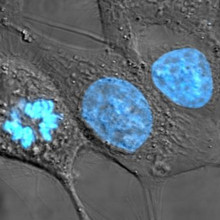
04:47 - Controversy over HeLa sequence
Controversy over HeLa sequence
with Nell Barrie
Kat - We're joined by science writer Nell Barrie, and the story we wanted to talk about this month was about the publication of the HeLa genome. Now, these are cancer cells that were taken from a black woman in the 1950s I think, who had a very aggressive cervical cancer and they were basically the first cell line to be grown in the lab. And now, they've just gone all over the world. That's like more volume of these cells than the poor woman who ever existed in the first place. But there's a lot of controversy around the publishing of her genome. What do you think?
Nell - Well, I think it's a really interesting story and I think probably the first time most people heard of Henrietta Lacks with the book that was published recently, looking at the history of her life, what happened to those cells after she died and how essentially, she and her family were never involved or asked for their consent in any of the research that went on. I think people were quite surprised when the genome was published because it quickly turned out that once again, they hadn't asked her family for the consent to publish this genetic data. I mean obviously, I think most people would realise now that there's some quite interesting implications there because they're publishing her entire genome which obviously, her family share quite a lot of. So the question is, whose data is this, should they have asked them, and how do we resolve these kinds of issues in the future, I guess.
Kat - This is one of the themes that was coming out of the Genetic Society Spring Meeting is that it's not just your genome. You got a bit from your mum and dad, and you're passing it onto your children as well, and even your more distant relatives down the line will share some of your genes. So, I think the idea that - could you piece together what these, what her children or her grandchildren are like from her genome is an interesting question. And some people say, "No, you can't. It's all been messed up. You can't tell." But then other people have actually done a little bit of analysis and you kind of can.
Nell - Yeah, exactly and I think there was a quite interesting point made about when we're thinking about consent for these things. For example, when you've got things like organ donation, a person can consent to organ donation and then in some situations, that can be overturned by their family because they may not be happy about that after the person has died for example. Could that be the case with this type of information? You might consent and say, "I'm happy for my genetic data to be used" but then, as you were saying, essentially it's not just your data. So, who else needs to have consent? Who else needs to be consulted? What's really coming out of this is the fact that we've got all these data, we've got all this amazing sequencing technology now, we can do this so quickly, and the kind of law and the ethics just isn't keeping up with this.
Kat - I mean, policy takes years and years to thrash out and we're just cranking out genomes at a rate of knots. Now, it was the European Molecular Biology Laboratory EMBL that published this sequence and then quietly took it down after there was quite a few complaints about it, but with regard to the question of consent and whether this was ever consented for which it wasn't consented to publish it. Back when her cells were taken, they were taken from discarded tissue from when she was operated on and there was no kind of consent back then. So legally, the researchers don't have to do this. I think they are now working with the family to try and work out how to go forward.
Nell - Yeah, it's the kind of the way they expressed it is that it's this weird kind of limbo area. So, nobody is suggesting that the researchers broke any rules at this point, but it's more about what is ethically right, what should the kind of moral standpoint be, and I suppose, it's just interesting to think about how people might get involved in this type of research in the future because what's clear is that people are really willing to take part and help and to contribute tissue to clinical trials for example, and for that to be used later on in studies. But then it's really about how you can consent and the issue about informed consent, and do you really understand what that data is going to be used for. And the researchers who are taking samples right now, they may have no idea about the potential ways that could be used say, 10 years down the line if it's been stored in a freezer or something. So, it's really this kind of evolving field and I think the fact that we haven't got kind of international laws around these things makes it really, really difficult.
Kat - Yeah, that's an area that really needs to get sorted out. And also, the fact that it isn't just your consent. It's your family too, but how do we try and sort this out without hindering research and hindering research in the future, and without invading people's privacy in a way they might not want to is really challenging issue. But yeah, thanks for mulling that over with me, cheers!
Nell - Thanks!
Kat - That's Nell Barrie, science writer.

09:22 - Turtle genome comes out of its shell
Turtle genome comes out of its shell
New data from the turtle genome has helped to shed light on the evolutionary mystery surrounding these unusual creatures, thanks to a paper published in the journal Nature Genetics by the Joint International Turtle Genome Consortium, led by researchers in Japan, China and the UK.
Turtles have a unique body plan, and a highly intriguing shell structure, and the new evidence suggests that they're actually related to birds and crocodiles, not to mention extinct dinosaurs, rather than being primitive reptiles as was previously thought. The scientists studied the green sea turtle and Chinese soft-shell turtle, and think that turtles must have split off from their dinosaur-like relatives around 250 million years ago, during the worst ever mass extinction - a catastrophe known as the Permian-Triassic extinction.
The research also helps to explain how the turtle's shell evolved, by hijacking genetic information normally used to encode limbs, providing more clues as to how subtle genetic changes can drive dramatic changes in what an organism looks like. And as an added bonus, the scientists discovered that turtles have an unusually large number of olfactory receptors, allowing them to sniff out a huge variety of different things. The soft shell turtle has more than a thousand - among the most ever found in a non-mammalian vertebrate - although quite what it's doing with them all isn't known.

10:44 - Converting bad fat to good
Converting bad fat to good
Scientists in Switzerland are the first to show that the two different types of fat in mammals - brown and white fat - can be converted from one to the other, challenging current understanding of fat cell fate. So far this research has been done using mice, but in the future it might lead to potential anti-obesity treatments.
White fat is the blobby stuff under our skin and around our organs. These fat cells get filled up with fatty droplets in good times and emptied when we need extra energy. In contrast, brown fat is only found in certain places in the body - although there's a relatively large amount in newborn babies - and burn fat and sugar to help maintain body temperature. Switching white cells into brown ones could be a handy way to lose weight by burning off extra calories, but until now this wasn't thought to be possible.
Writing in the journal Nature Cell Biology, the scientists focused on so-called 'brite' fat cells, which are brown-type cells that form within white fat in response to cold temperatures. Using special cell-tracing techniques, they discovered that these cells are generated by white fat cells switching fate as it gets chilly, rather than being generated by specific brown fat precursor cells. And not only did white fat switch into brown when it gets cold, they can switch back when the temperature warms up.
The researchers are now trying to track down exactly how this works, so they can design drugs that might push fat cells from white to brown and help burn up more calories. Sadly, this isn't going to help humans lose weight any time soon, but it's an important step on the road to understanding how different types of fat are formed, and how they might be manipulated.
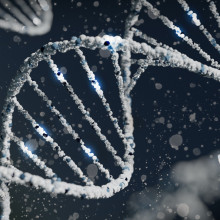
12:34 - Prof Jim Lupski - Genome sequencing
Prof Jim Lupski - Genome sequencing
with Dr Jim Lupski, Baylor College of Medicine, Texas
Kat - Now it's time to hear more from the Genetics Society Spring Meeting. First, here's Professor Jim Lupski from Baylor College of Medicine in Houston, Texas - who was one of the team that sequenced the genome of Nobel Prize-winner James Watson. He explains how new techniques, including whole genome sequencing, are shedding light on rare genetic diseases, including one that affects him - Charcot Marie Tooth disease.
Jim - One of the examples which I talked about is the Beery twins - and the family has no problem with their name being used - where the family struggled for many years with the children having all kinds of problems related to their condition. And finally, it was the mother who read a lot in the literature and she convinced neurologists to try them on a little bit of L-dopa which you use to try to bypass the dopaminergic system when there's some abnormality there. And they were remarkably improved overnight when they got that L-dopa.
But years later, there continued to remain problems as they grew, though not as bad as before. So, there was a question whether too much of the medicine was being given, or too little of the medicine, what was going on and we went and sequenced the genome and to our surprise, they had a very rare form of this disease where in fact, they had a mutation in one of the vitamin cofactors required for that enzyme to work. But it's also required for other enzymes in a different neurotransmitter pathway.
So, when we gave them a little bit of the compound that bypassed the other serotonergic pathway, they really were improved dramatically and it really helped the family a lot. And so, I would say it's interesting because the twin girl who couldn't participate in athletics before the genome sequence and the treatment, now had become a champion runner and also, very good at the trampoline and she broke her arm on the trampoline. So, now that we were treating her, she broke her arm. Is that a physician-caused problem? I don't know.
Kat - And that's great, finding the two hits rather than just the one pathway. Do you think that that's going to be common in some of these complex diseases?
Jim - That's a very good question and as I tried to point out when we put this into the clinic, we were quite surprised to find that almost 1 in 20 individuals had two different genes where the mutations seem to be playing a role in their susceptibility to those clinical conditions they had. And that can make it look very complex and difficult for the physician to make a diagnosis based on what they observe clinically because actually, it's a mixture of two different things. So, I think that's another place where we could not have anticipated that before introducing it clinically that this would occur, but it will change our thinking a little bit.
Kat - And you've got your own personal experience of having your genome sequenced. Can you tell me a bit about that?
Jim - It was a very interesting experience because I had studied this disease, Charcot-Marie-Tooth neuropathy, and although we had found the cause of that disease and novel mutational mechanisms, after 25 years, I still didn't know what my disease was due to. So, we tried to see if genomic sequencing could find that and sure enough, we did find that. But you know, sequencing your own genome and what are the potential ramifications, that's just never been done before.
Kat - Because you could find all sorts of things in there.
Jim - Yes and we did, okay, and that's certainly when everybody's started talking about incidental findings. We found [a variation] in the literature, reported in a 9-year-old who was in a persistent vegetative state, but I didn't have a persistent vegetative state, okay. And in fact, as we investigated that further, the database was wrong. There are other incidental findings that also, the analysis misinterpreted what that was. We did not find any other cancer susceptibility or other incidental findings that had to be medically actionable. So, yeah, it was a little scary at first because we didn't know what we were going to find. But being scared won't stop you from moving forward. Look, about moving forward, we know where to focus studies of my own disease. So, we made the mutations in animal models now and we're starting to study it there.
Kat - So, I guess is there a possibility you might go from the genetic study of your own personal disease to finding a treatment in the lab for your own disease and then hopefully other people too?
Jim - Potentially, okay. In the meantime, there's a lot to be said for knowing the molecular diagnosis, both in terms of truly, that was the first time we could truly, truly say this is a recessive gene and recessive mutation. We had it there in the genome. We watched it go between parents and grandparents and the children. So, I think knowing a diagnosis in and of itself can be extremely helpful in the family. Even if the family says, "Well, I know I have the disease" or "I know I don't have it" but actually, from the clinician perspective, it could be useful also.
Kat - And just to look into the future, where do you think we'll be with gene sequencing in 10 years or even just in 5 years?
Jim - To me, it was almost a surreal experience sequencing Jim Watson's genome and then looking at the variation and sitting in a room and trying to explain to him what some of this might mean. Well of course, we didn't know what we were doing and just also to think that that man was involved here in this country in helping to elucidate the structure of DNA. And in his lifetime, he never thought somebody would be talking to him about his own genome and what the variation might be. That was 5 years ago and now, we've already heard the announcement of 100,000 genomes in the UK. With the disruptive technology, the internet, the computer, the cell phone, it's really hard to know what will happen and how fast it will happen. I do think that the information may very much empower the patient even more in their own healthcare. That's what I would hope then.
Kat - That was Professor Jim Lupski from Baylor College of Medicine.
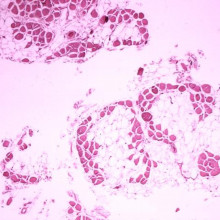
20:45 - Prof Kate Bushby - Genes to treatments
Prof Kate Bushby - Genes to treatments
with Professor Kate Bushby, University of Newcastle
Kat:: While it's useful to track down the gene faults responsible for rare genetic diseases, what patients and families really want are cures. And although individual rare diseases are by definition rare, added together they affect a significant proportion of the population. But while many scientific papers over the years have loudly proclaimed that finding a particular gene will "lead to new therapies", the reality is that progress in turning genetic data into treatments has been slow. I spoke to Professor Kate Bushby from Newcastle University, to find out how close we are to making this a reality.
Kate - I think that the disease I particularly work on Duchenne muscular dystrophy, forms a very, very good and saultary example of where we're going in that direction. Because the gene for Duchenne, the dystrophin gene, was identified in about 1986 and here we are in 2013 with maybe a couple of therapies about to get conditional approval, but we don't have disease transforming therapies on the cards for patients at the moment. And I think that's because we haven't really taken enough notice of the very long pathway that it takes to get new developments in genetics through the animal models into the trials and into the patients. And we haven't seen the drugs getting into clinic so far because of the time that that takes to assemble the patients, to train sites to the trials, to understand what the outcome measures are. And these are the barriers to translation research in rare diseases which we probably haven't addressed this dramatically enough as yet in order to truly benefit in the advances in genetics.
Kat - What are some of the key players in this who really need to get their act together to make a difference to patients with rare diseases?
Kate - So, key to all of these are the patients' organisations because with rare disease research in particular, they frequently provide the impetus for a group of doctors or a group of researchers to start working on a particular disease. They often provide seed funding for that and they also often contribute at a very great level to the development of patient registry. So you need your patient organisations on board. You need the researchers who make their initial discoveries and who, perhaps make these grandiose statements about how genetic discoveries are going to turn into therapies, to really get their head around what that means. We don't educate our scientists enough about the translational pathway I think so the basic scientists are a little naïve when it comes to understanding what the pathway is for the majority of them. And then the doctors, the people who see the patients need to understand the importance of directing them towards registries, whereby they can get linked into research. They need to become involved in developing natural history studies which will allow us to understand outcomes better and if possible, they need to get their resources in their own centre to get the trials up running as well. So, it's a partnership. All of these things are very much partnerships and we need to collaborate in order to make it work.
Kat - And I guess one of the big challenges is the money, and the money to develop drugs, the cost of drugs, and then just the money to fund the research. Where is that coming from?
Kate - Well, rare disease research has been getting some investment recently. The International Rare Disease Research Consortium known as IRDRC has brought together funders in rare diseases with the ambitious aims of having 200 new therapies for rare diseases by 2020 and diagnoses for all rare diseases by that date. So, there's a new emphasis on rare disease research which leads of course always to a little bit more money. The European Union has funded research in rare diseases at quite a high level and continues to do so, and that's a great priority of them. National funders have other priorities of course, but it's beginning to creep onto the agenda, and pharma is the newcomer on the block. Pharma is beginning to really make a difference to funding of therapy development in rare diseases, adding to the previous landscape where small patient organisations are often struggling to try and make progress. We now have a much broader range of funding opportunities available in this area.
Kat - And with the explosion that we've got in gene sequencing and understanding the genetics involved in the diseases, do you hope it will be faster than what it's taken for the research in Duchenne to get to the clinic?
Kate - It should be faster. We have new tools at our disposal. We've learned a lot. The worry is that what we learn in the Duchenne field isn't extended to other areas. So, other people have to start from scratch and sharing of information through meetings such as this and through other mechanisms for the collaboration are really, really important. And I think that's beginning to happen across the rare disease community because every new discovery shouldn't have to reinvent the wheel in terms of the processes by which they bring drugs to development. And there's a lot that people have learned so we should share that.
Kat - That was Professor Kate Bushby from Newcastle University.
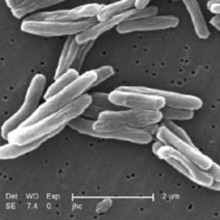
Can bacteria lose resistance to drugs?
Martha:: Listener Ed Wilson wanted to know whether bacteria can lose resistance to a certain antibiotic when it's removed from their environment. I spoke to Julian Parkhill at the Wellcome Trust Sanger Institute who told me that antibiotic resistance can be a costly process to the bacterium. Removing the antibiotic from the bacterium's environment means that sensitive bacteria may have an advantage as they don't have to maintain these energy costly resistance mechanisms. And so, sensitive bacteria may begin to outcompete their resistant neighbours. But as Dr. Parkhill explained, the situation isn't always this straightforward.
Julian:: The cost to the organism is often very, very low because the antibiotic resistance mechanism is kept under tight control and only used when the antibiotic is around. This means that when there's no antibiotic around, there's very little cost because of the tight control the mechanism is kept under. Also, where there is a cost, when the organism is subject to antibiotic pressure, it can often mutate and you get what's called compensatory mutations which will make the organism more fit even in the absence of antibiotic. And the final issue is that you often find that antibiotic resistances get linked together. So, if an organism is resistant to one antibiotic, it will often carry resistances to multiple different antibiotics. So, that means that even if it's not being exposed to one particular antibiotic, the resistance mechanism may still be linked to a number of other resistance mechanisms. And therefore, whatever antibiotic is used, the organism will maintain a number of other different resistance mechanisms in the population. So overall, although it can happen and sometimes antibiotic resistance is lost if an antibiotic's not being used, nature has a number of ways of maintaining these things in the population, even in the absence of the antibiotic.
Martha:: So, antibiotic resistance mechanisms may persist in bacterial populations, long after an antibiotic is removed from its environment. Thanks to Ed Wilson for his question and to Julian Parkhill from the Sanger Institute for his answer.
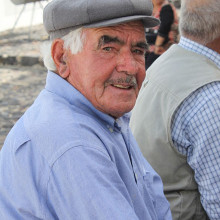
27:45 - Gene of the month - INDY
Gene of the month - INDY
with Kat Arney
And finally, our gene of the month is INDY, short for I'm Not Dead Yet. It owes its name to a scene in the film Monty Python and the Holy Grail, where plague victims are being dumped in a cart for burial despite one of them protesting that he's very much alive. First discovered in 2000 by Stephen Helfand and his team in the US, flies with a mutated version of INDY live around twice as long as usual, extending their lifespan from the normal average of 37 days to between 69 and 71 days, while appearing to be perfectly healthy.
Researchers think that INDY is involved in helping cells to control their metabolism - how they get energy from food. This is something that's known to be involved in longevity, and extremely low-calories diets can help to extend lifespan in certain animals, although it's not clear about humans just yet.
Switching off INDY in tiny C. elegans worms can also extend their lifespan, and there's also a version in mammals - mostly active in the liver in mice. In these animals, switching off INDY in the liver helps to protect them from getting fat and developing insulin resistance - a precursor to type 2 diabetes - when they're on a high calorie diet. Although it's not yet clear whether switching off INDY in mice helps to extend their lifespan, the research so far suggests that it could be a good target for drugs aimed at treating type 2 diabetes, obesity and other metabolic diseases. And - who knows? - maybe even helping us to live longer, one day.
- Previous Digoxin: Chemistry in its element
- Next Science Toys, for Boys?










Comments
Add a comment